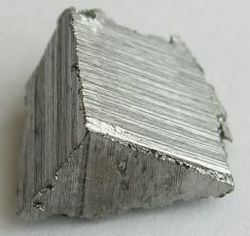Erbium
Erbium's principal uses involve its pink-colored Er3+ ions, which have optical fluorescent properties particularly useful in certain laser applications. Erbium-doped glasses or crystals can be used as optical amplification media, where erbium (III) ions are optically pumped at around 980 nm or 1480 nm and then radiate light at 1530 nm in stimulated emission. This process results in an unusually mechanically simple laser optical amplifier for signals transmitted by fiber optics. The 1550 nm wavelength is especially important for optical communications because standard single mode optical fibers have minimal loss at this particular wavelength. In addition to optical fiber lasers, a large variety of medical applications (i.e. dermatology, dentistry) utilize the erbium ion's 2940 nm emission (see Er:YAG laser), which is highly absorbed in water in tissues, making its effect very superficial. Such shallow tissue deposition of laser energy is helpful in laser surgery, and for the efficient production of steam for laser enamel ablation in certain types of laser dentistry.
Occurrence
The concentration of erbium in the Earth crust is about 2.8 mg/kg and in the sea water 0.9 ng/L. This concentration is enough to make erbium about 45th in elemental abundance in the Earth's crust.
Like other rare earths, this element is never found as a free element in nature but is found bound in monazite sand ores. It has historically been very difficult and expensive to separate rare earths from each other in their ores but ion-exchange production techniques developed in the late 20th century have greatly brought down the cost of production of all rare-earth metals and their chemical compounds.
The principal commercial sources of erbium are from the minerals xenotime and euxenite, and most recently, the ion adsorption clays of southern China; in consequence, China has now become the principal global supplier of this element. In the high-yttrium versions of these ore concentrates, yttrium is about two-thirds of the total by weight, and erbia is about 4–5%. When the concentrate is dissolved in acid, the erbia liberates enough erbium ion to impart a distinct and characteristic pink color to the solution. This color behavior is similar to what Mosander and the other early workers in the lanthanides would have seen in their extracts from the gadolinite minerals of Ytterby.
| Symbol | Er | |
| Atomic Number | 68 | |
| Atomic Weight | 167.26 | |
| Oxidation States | +3 | |
| Electronegativity, Pauling | 1.25 | |
| State at RT | Solid, Metal | |
| Melting Point, K | 1802 | |
| Boiling Point, K | 3136 |
Appearance and Characteristics
Harmful effects:
Erbium is considered to be moderately toxic.
Characteristics:
- Erbium is a bright, soft, malleable, silvery-white metal.
- It is one of the rare earth metals.
- The metal slowly tarnishes in air, reacts slowly with water and dissolves in acids.
- When present in compounds, erbium exists mostly in the trivalent state, Er3+. Erbium salts are a rose pink color.
Uses of Erbium
- Erbium isotopes are good neutron absorbers and are used in nuclear reactor control rods.
- The oxide erbia is used as a pink coloring agent in glazes and glasses.
- Erbium is used in alloys especially with vanadium to decrease the hardness of metals.
- It is also used in amplifiers and lasers.
- Erbium is used in photographic filters to absorb infrared light.
- Erbium is also used in yttrium aluminum garnet (YAG) medical lasers for procedures involving skin resurfacing such as acne scars, mole removal tattoo removal and warts.
